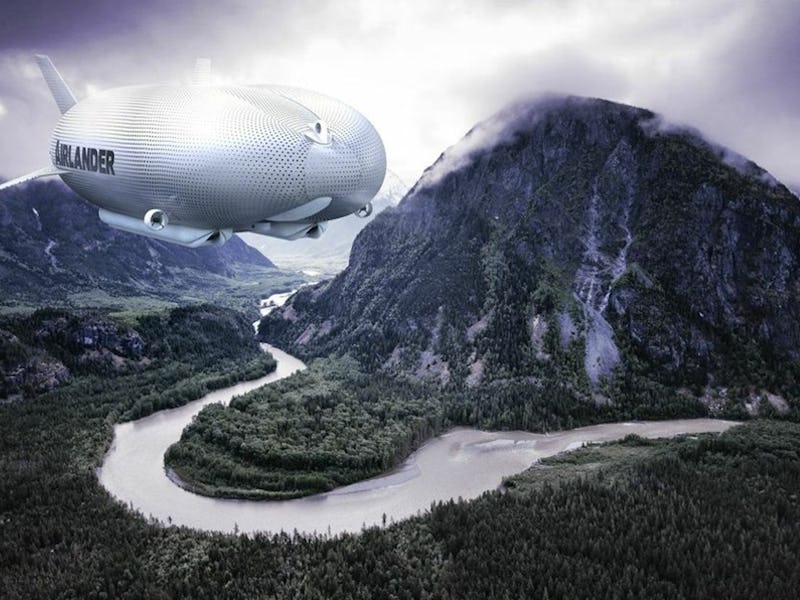How Airships Like the Airlander 10 Could Replace Cargo Planes in Just Years
The inflating possibilities of airships.

Ever since the Hindenburg went up in flames, aeronautic manufacturers have dreamed of a future in which massive airships might one day dominate our airways. However, jets quickly emerged as the safer, faster, and more cost effective way to transport people and cargo through the skies.
Now, with the hype around Hybrid Air Vehicles’ (HAV) Airlander 10, the largest aircraft in the world, it seems the dream is once again alive. The company is touting a number of possible uses for the impressive floating airship, including scientific surveillance of marine life, leisure air cruises, and, yes, transporting huge amounts of goodies through the sky.
“The big market and the ultimate goal is opening up the world through cargo and trade opportunities,” Chris Daniels, head of partnerships at HAV, tells Inverse. “But our feeling is that’s a bit more of a long-term goal. That market will wait until there’s a finalized product.”
Airlander 10 is capable of staying afloat for up to five days while in operation or more than two weeks unmanned. And it doesn’t need any specific infrastructure to land or float above a drop-off location. Barry E. Prentice, professor in the department of supply chain management at the University of Manitoba’s I.H. Asper School of Business, says Airlander 10, or other larger airships like it, could be the solution to an unresolved problem in the cargo transport industry.
The view of the cockpit of the Airlander 10.
“Roughly 70 percent of Canada’s landmass has no roads or rail lines, so we have a huge area that’s basically inaccessible except to small airplanes,” Prentice tells Inverse. “We really do have a very large need for a better system of lifting bigger pieces and bigger sizes that you can’t fit into an airplane door, into all kinds of places … A lot of places around the world are inaccessible.”
In fact, Prentice says the potential for airships is so strong that he predicts they’ll completely overtake the market of cargo planes in seven to 10 years.
Passenger jets have long been more dominant in the market than cargo jets and the industry has been in decline since its peak in 2011. The International Air Transport Association reported 2015 was “another very difficult year for air cargo,” as growth slowed and revenue declined.
Since trains, trucks, and cargo boats can’t reach many parts of the world, Prentice predicts airships will come to fill that void. And he says it would happen even sooner if world economies were “more serious” about climate change.
DHL cargo planes sit on the tarmac at Halle-Leipzig Airport on February 28, 2014 in Leipzig, Germany.
“If we start to put a carbon tax on fuel, airplanes are going to get very expensive,” says Prentice. “An airship doesn’t burn very much fuel, maybe at the outside of a quarter of what an airplane would burn. On top of that, you can use an alternative fuel like natural gas or hydrogen.”
However, he says, while designs such as the Airlander 10 make for a good starting point, vessels like it will eventually have to be even bigger to compete with other modes of long distance cargo transport.
“As the ships get bigger, they get much better. The cost of building a bigger airship is not much more,” says Prentice. “You’re never going to make money in a pickup truck driving halfway across the country. You just need to have more cargo per mile, in terms of your revenues, to pay for the ship.”
Jean-Paul Rodrigue, a professor at Hofstra University’s Department of Global Studies & Geography, says it’s the size that’s holding the vessel back from being a real competitor with other oceanic cargo vessels.
“It’s not actually that suitable for long distances,” Rodrigue explains to Inverse. “The longer the distance, the less competitive it is with other transportation modes. Crossing the ocean would not make sense.”
In comparison to freight ships, the Airlander could never transport as much cargo in one trip. Water is 1,000 times more dense than air, Prentice says, meaning a ship that could carry 1,000 tons by sea could only carry one ton by air.
A container ship from China Shipping Line is loaded at the main container port August 13, 2007 in Hamburg, Germany.
However, he says there are pluses to using airships in oceanic travel. An airship can actually carry more weight than normal when it flies at low altitudes over water (since the air above the ocean is more dense), and it can even provide a smoother ride than what a freight ship beset by choppy waves can. Not to mention, airships don’t have to stop at the shore.
He proposed the idea of a shipment that needed to be made between London and Chicago. An airship could go directly to the destination in roughly 48 hours, whereas a freight ship, while potentially cheaper and able to carry more, might take up to two weeks after loading, unloading, and traveling inland by truck.
“It’s a question of speed – and also what you’re carrying and how delicate it is,” says Prentice. “Each mode of transport has a niche.”
Cargo airplanes once filled this niche, but if airships can prove an ability to be cheaper, more reliable, and carry more shipments per load than cargo planes, there could be a lot more in the skies.
“It’s quite possible to envision airships becoming much more attractive simply because of the cost differential,” says Prentice. “The technology is really well known. It’s not like we have to reinvent the wheel, it’s just applying our engineering and our money to build these things.”